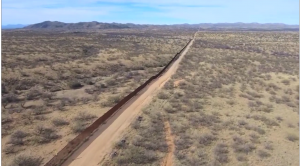LatinaLista — Juarez may literally be under siege these days by drug cartels that would like to stifle any kind of expression, whether it be from the people, the news media or the artists.
One Juarez artist, Gilda Lorena Martínez, refuses to cease expressing herself the best way she knows how, though in the last two years it’s been a struggle. Over the last 24 months, she’s seen close friends die, was assaulted, got seriously ill and lost most of her business as an art teacher because people are fleeing the city.
 Titled “Ciudad de Arena y Sangre” (City of Sand and Blood) is the namesake of the exhibit.
Titled “Ciudad de Arena y Sangre” (City of Sand and Blood) is the namesake of the exhibit.
In a rather defiant gesture towards what is happening in Juarez, Martínez, a world-recognized artist, is hosting a 15-piece art exhibit in Juarez at the Museo de Arqueologia del Chamizal.
The exhibit opens today, Feb. 17, and continues through March 13. The showing is entitled “Ciudad de Arena y Sangre” (City of Sand and Blood). The exhibit is the culmination of two years of working on a series of paintings responding as an artist and a Juarense to the city’s security and economic crises.
In a short Q&A with Latina Lista (LL), Martinez explains how what is happening in Juarez affects her as an artist, a Mexican citizen and a mother.
LL: How does what is happening in Juarez impact your style of painting? Your choice of colors? Your decision to depict a particular scene?
GLM: My line and language are recognizable for those who know my work, but this series shows a radical change. I used to look within (for inspiration) and my work generally showed a woman, in her most aesthetic form and in her different social roles, as the central figure.
Now worn-out characters have entered my work and they’re shown in scenes that range from hell to funerals. Music surfaces from darkness, bad guys reveal their rites, neighbors fearfully peek their heads out, spirits fight for heaven and hell and show their worst aspects, and of course death makes several appearances.
My palette changes from warm, earthy and harmonious tones to cold, gray and dark colors, although red often splashes the canvas.
LL: What do you hope the people of Juarez take away from your exhibit?
GLM: First of all, as an artist my intention was not to turn away and assume my social responsibility to document this historical event. But in short, acknowledgment of the situation.
The attitude of many Juarenses two years ago was to avoid the reality of what was happening. It was a total lack of conscience caused by the fear of facing what was happening in the city.
It had to be said and it had to be assumed, we had to recognize the critical state of the city and what the consequences meant to us as a society, as individuals, as parents, as sons and daughters and, worst of all, we would have to change our lifestyles.
We ignored just how far this situation could go but time, the deaths of our friends and loved ones and the levels of delinquency would make us react and recognize that the city was falling apart.
After two years, which is the time frame in which I put together this series, my purpose concretely was to recognize and create conscience of the painful situation that we were living and from there perhaps start formulating actions for the recovery.

“Balas Benditas” (Holy Bullets)
LL: What do you hope people who don’t live in Juarez take away from your exhibit?
GLM: What we Juarenses have lived through in this long time, I think. It’s important to show the world not only statistics and headlines, but also people’s misfortunes, their mourning (like my piece “Funeral of the Innocents”), the disintegration of their families, their economic loss, their bereavement after an extortion.
People from Ciudad Juarez had to be shown not as executions statistics, nor as a landscape of drug dealers that’s discussed in terms of winners and losers, of mob bosses and gangs, of bombs and ballistics. It had to be shown that the society of Juarez is composed of people who are hurting. The social effects that arose from this situation had to be shown, like the religious ceremonies in the parks (“Evangelization of the Dessert”), the closed-off streets (“Labyrinth of the Forgotten”), and the parents who had to send their children to other states or countries to give them a better lifestyle (“Empty Nest Depression”).
The fear, the anguish and the desperation of the inhabitants of this city (“Beyond Imploring”) had to be shown.
LL: What is your emotional state of mind when painting any of these paintings?
GLM: I was emotionally devastated. I began this series two years ago when I was forced by the city’s circumstances to close my children’s art workshop, which I founded in 1998 and was in complete ascendance.
One day, I took a discarded door that I had at my workshop and I painted it after a few months. It was a cathartic process after the murder of a person dear to me. This was the first painting of this series, “City of Sand and Blood.”
Here was the story of the city, the women, the death, the soldiers, the executions. I still didn’t have it all at a conscious level. And then came my second piece, ” View of the Collapse from Within,” where I had to recognize the fear and the confinement (of having to lock ourselves in our homes).
The other pieces followed in a similar fashion. My weight and my health deteriorated to the point I could no longer remain standing for more than 15 minutes at a time. However, I continued to produce, even though I had to make a pause because you can’t paint pain without feeling it.
All this went beyond my capacity, so I left the city for five months to be treated by a doctor. I came back to breathe in the fear. I was assaulted. My friends continued to suffer and eventually other pieces portraying the different angles of this social phenomenon emerged.
And it wasn’t just what I saw and heard from the news and people anymore. I became interested in the general profile of this situation and I even took on topics dealing with the drug traffic, like the characteristics of these individuals, which called my attention.
To date, I have 25 pieces and I’m sure that more will come since it’s impossible to stop seeing what’s going, although I think that very soon paintings portraying hope and solutions will emerge.
LL: It was mentioned that you want to immigrate to the United States? Why the US?
GLM: The most important thing in my life are my children and in the last years they have made their lives and careers in the United States. I didn’t have the chance to be with them at very important moments of their lives and this has caused me a lot of pain.
(Editor’s Note: Special thanks to Alejandro Martinez-Cabrera for arranging the interview and translating.)




